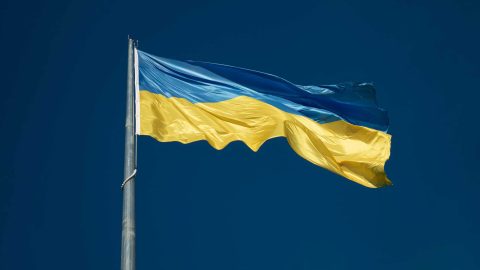The risk of an escalation of the geopolitical conflict between Russia, Ukraine and NATO has risen further in recent days.
Meanwhile, the conflict has replaced rate hike expectations as the dominant factor driving price movements. Risk premiums have risen, as can be seen from the price losses in risk assets such as equities, the weakening of the Russian ruble and the rise in yield premiums for Russian government bonds denominated in US dollars.
Motivation
The motivation of the parties is not hidden, but communicated clearly and credibly. In principle, it is that Russia wants to keep Ukraine in its sphere of influence. In any case, Ukraine should not become a member of NATO, not even in the long term. Obviously, Russia wants to maintain the buffer zone between itself and NATO, which shrank with the expansion of NATO to include some Eastern European countries. After all, five NATO members already border Russia (Estonia, Latvia, Lithuania, Poland and Norway).
If Ukraine were to leave, only Belarus would remain. Ukraine, in turn, is in favor of a rapprochement with NATO. After the seizure of the Crimean peninsula and the smoldering conflict in eastern Ukraine, the desire has probably become even greater. The West’s position is also clear. A sovereign state should decide for itself on its geopolitical status (alliance, non-aligned, neutral).
Credible threat
The fronts are hardened. In general, goals are more likely to be achieved if credible competence is conveyed. Russia has reportedly deployed 130,000 troops. However, capabilities go beyond that. The buzzword is “hybrid warfare.”
The conflict can be fought on many levels (cyberspace, attacks, disinformation). Ukraine seems to have little to credibly strengthen its own position. The West has threatened sharp and severe non-military consequences.
Public opinion
Whether the threatening gestures will be translated into action, and in what form, also depends heavily on public opinion. According to reports, the majority of the populations of Russia, Ukraine and the West reject escalation. An essential question is which state can nevertheless more easily force an escalation (Russia with invasion, the West with sanctions). Here, an authoritarian state has an advantage.
Transparent weighing
In principle, then, the question now is whether for Russia the benefits of a buffer zone outweigh the cost of (perhaps not quite so dire and temporary) sanctions. The West would have to signal very substantial sanctions just to somehow credibly support its own position. That certainly happens in the various diplomatic meetings. For both sides (Russia and NATO) the threatening gestures are credible, perhaps those of Russia weigh a little more.
Critically, both sides (Russia and NATO) should be clear about the respective costs (high on both sides) and benefits (buffer zone vs. sovereignty). This transparency increases the likelihood of a negotiated settlement. Ultimately, all three parties – including Ukraine – would have to share this assessment. The pressure from both sides (Russia and NATO) on Ukraine is likely to be very great at present to propose something like freedom from alliance (without conditions) itself.
Oil price shock
The situation is similar to a poker game. The signals must be credible. This is also reflected in the falling prices of risk assets due to the increased likelihood of an escalation in Ukraine. We can only hope that a negotiated solution will eventually be reached. In the meantime, the development of the oil price is (also) at the center of the driving factors.
The price of a barrel of crude oil (Brent) has climbed to almost USD 94. In the past, oil price shocks (rapid and sharp price increases) have been (partly) responsible for triggering a recession on several occasions.
Legal note:
Prognoses are no reliable indicator for future performance.
Legal disclaimer
This document is an advertisement. Unless indicated otherwise, source: Erste Asset Management GmbH. The language of communication of the sales offices is German and the languages of communication of the Management Company also include English.
The prospectus for UCITS funds (including any amendments) is prepared and published in accordance with the provisions of the InvFG 2011 as amended. Information for Investors pursuant to § 21 AIFMG is prepared for the alternative investment funds (AIF) administered by Erste Asset Management GmbH pursuant to the provisions of the AIFMG in conjunction with the InvFG 2011.
The currently valid versions of the prospectus, the Information for Investors pursuant to § 21 AIFMG, and the key information document can be found on the website www.erste-am.com under “Mandatory publications” and can be obtained free of charge by interested investors at the offices of the Management Company and at the offices of the depositary bank. The exact date of the most recent publication of the prospectus, the languages in which the fund prospectus or the Information for Investors pursuant to Art 21 AIFMG and the key information document are available, and any other locations where the documents can be obtained are indicated on the website www.erste-am.com. A summary of the investor rights is available in German and English on the website www.erste-am.com/investor-rights and can also be obtained from the Management Company.
The Management Company can decide to suspend the provisions it has taken for the sale of unit certificates in other countries in accordance with the regulatory requirements.
Note: You are about to purchase a product that may be difficult to understand. We recommend that you read the indicated fund documents before making an investment decision. In addition to the locations listed above, you can obtain these documents free of charge at the offices of the referring Sparkassen bank and the offices of Erste Bank der oesterreichischen Sparkassen AG. You can also access these documents electronically at www.erste-am.com.
Our analyses and conclusions are general in nature and do not take into account the individual characteristics of our investors in terms of earnings, taxation, experience and knowledge, investment objective, financial position, capacity for loss, and risk tolerance. Past performance is not a reliable indicator of the future performance of a fund.
Please note: Investments in securities entail risks in addition to the opportunities presented here. The value of units and their earnings can rise and fall. Changes in exchange rates can also have a positive or negative effect on the value of an investment. For this reason, you may receive less than your originally invested amount when you redeem your units. Persons who are interested in purchasing units in investment funds are advised to read the current fund prospectus(es) and the Information for Investors pursuant to § 21 AIFMG, especially the risk notices they contain, before making an investment decision. If the fund currency is different than the investor’s home currency, changes in the relevant exchange rate can positively or negatively influence the value of the investment and the amount of the costs associated with the fund in the home currency.
We are not permitted to directly or indirectly offer, sell, transfer, or deliver this financial product to natural or legal persons whose place of residence or domicile is located in a country where this is legally prohibited. In this case, we may not provide any product information, either.
Please consult the corresponding information in the fund prospectus and the Information for Investors pursuant to § 21 AIFMG for restrictions on the sale of the fund to American or Russian citizens.
It is expressly noted that this communication does not provide any investment recommendations, but only expresses our current market assessment. Thus, this communication is not a substitute for investment advice.
This document does not represent a sales activity of the Management Company and therefore may not be construed as an offer for the purchase or sale of financial or investment instruments.
Erste Asset Management GmbH is affiliated with the Erste Bank and austrian Sparkassen banks.
Please also read the “Information about us and our securities services” published by your bank.



